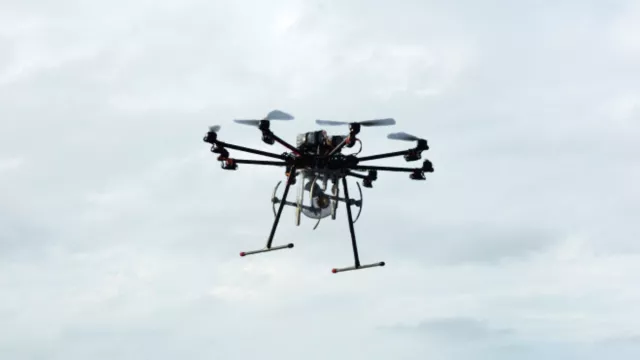Bridging the gap between numerical simulations and real-life launcher testing, multicopter drones offer an effective way to validate algorithms quickly and economically. SWING is studying the concept’s feasibility on the concrete test case of fuel sloshing.
Key information
| Mission | Test flight-control algorithms in flight |
|---|---|
| Domain | Space transportation |
| Start date | 2015 |
| Partners | AERACCESS |
| Where | Brétigny-sur-Orge flight base |
| Lifetime | 4 years |
| Status | Completed |
Key figures
- 8 kg: mass of experiment payload
- 8 rotors
Key milestones
- 2019: End of project
- 2017: Octocopter flights
- 2015: Start of SWING project
Project in brief
The SWING project (Small Workshop for Innovative GNC) was born in 2015 out of the realization that the guidance, navigation and control (GNC) algorithms employed by multicopter drones in wide use today share many features with those of launch vehicles. Not only that, they are also quick and easy to implement, inexpensive and backed by a dynamic Open Source community, allowing teams to build a complete vehicle and easily adjust its flight plan.
Fuel sloshing was chosen as the first concrete case study. Sloshing characteristics—frequency, damping, etc.—are typically determined using shakers that generate vibrations of different frequency and intensity or by numerical simulations. In pilot studies, sloshing is replaced by pendula with the same properties to simplify calculations.
As far as we are aware, no other experiment has ever been devised to compare how a rocket behaves when filled with liquid and with an equivalent pendulum. This type of experiment is difficult to perform with a launcher but can be envisaged with a drone.
The teams at CNES’s Launch Vehicles Directorate (DLA, now DTS) developed an experimental device in which water in a tank can be replaced by an equivalent pendulum. The device is hooked up to a drone, which cycles oscillations at different amplitudes and frequencies. The experiment is performed first with the liquid and then repeated with the pendulum to verify that the pendulum is modelling parameters correctly.
A first quadcopter-type vehicle was used to validate the concept, after which the SWING team partnered with AERACCESS in 2017 to devise a more powerful octocopter—with eight rotors—capable of carrying the experiment payload of eight kilograms.
Tests were conducted at Brétigny-sur-Orge—a nod to history, as the drones took off only a few hundred metres from where CNES’s first facilities were located in 1962.
CNES’s role
CNES was the initiator of the SWING project.
Contacts
Head of Space Transportation Strategy
Philippe Pujès
E-mail: philippe.pujes at cnes.fr


